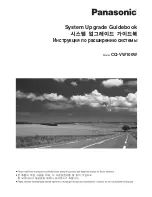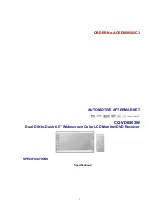
CX-3164
8
1
2
4
1
2
3
4
C
D
F
A
B
E
The servo block performs servo control such as error signal equalizing, in-focus, track jump and carriage move. The DSP
block is the signal-processing unit, where data decoding, error correction, and compensation are performed. The FE and
TE signals, generated in the preamplifier stage, are A/D-converted, and output drive signals for the focus, tracking, and
carriage systems via the servo block. Also, the EFM signal is decoded in the signal-processing unit, and ends up in
outputting D/A-converted audio signals through the D/A converter. Furthermore, in this decoding process, the spindle
servo error signal is generated, supplied to the spindle servo block, and used to output the spindle drive signal.
Each drive signal for focus, tracking, carriage, and spindle servos (FD, TD, SD, and MD) are output as PWM3 data, and
then converted to analog data through the LPF. These drive signals, after changed to analog form, can be monitored with
the FIN, TIN, CIN, and SIN signals, respectively. Subsequently, the signals are amplified and supplied to the actuator and
motor for each signal.
1.2.1 Focus servo system
The main equalizer of the focus servo consists of the digital equalizer block. The figure 1.2.1 shows the block diagram of
the focus servo system.
In the focus servo system, it is necessary to move the lens within the in-focus range in order to close the focus loop. For
that purpose, the in-focus point is looked for by moving the lens up and down with the focus search voltage of triangular
signal. During this time, the rotation of the spindle motor is retained at a certain set speed by kicking the spindle motor.
The servo LSI monitors the FE and RFOK signals and automatically performs the focus-close operations at an
appropriate timing. The focus-close operation is performed when the following three conditions are satisfied at the same
time:
1) The lens moves toward the disc surface.
2) RFOK = "H"
3) The FE signal is zero-crossed.
Consequently, the FE converges to "0" (= REFO).
When the above-mentioned conditions are met and the focus loop is closed, the FSS bit is shifted from "H" to "L," and
then, in 10 ms, the microcomputer starts monitoring the RFOK signal obtained through the low-pass filter.
If the RFOK signal is determined to be "L," the microcomputer takes several actions including protection.
Fig.1.2.2 shows a series of actions concerning the focus close operations. (It shows a case where the focus loop cannot
be closed.)
With the focus mode selector displaying 01 in the test mode, pressing the focus close button, allows to check the S-
shaped curve, search voltage, and actual lens behavior.
Fig.1.2.1 Block diagram of the focus servo system
1.2 SERVO BLOCK (UPD63763CGJ: IC201)
PWM
FD
101
6
11
12
FOP
FOM
LENS
IC301 BA5835FP
DIG.
EQ
CONTROL
www. xiaoyu163. com
QQ 376315150
9
9
2
8
9
4
2
9
8
TEL 13942296513
9
9
2
8
9
4
2
9
8
0
5
1
5
1
3
6
7
3
Q
Q
TEL 13942296513 QQ 376315150 892498299
TEL 13942296513 QQ 376315150 892498299
















































